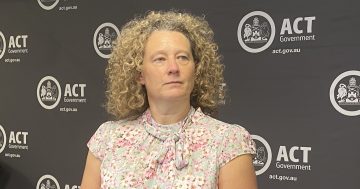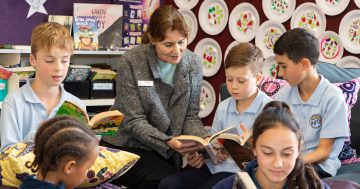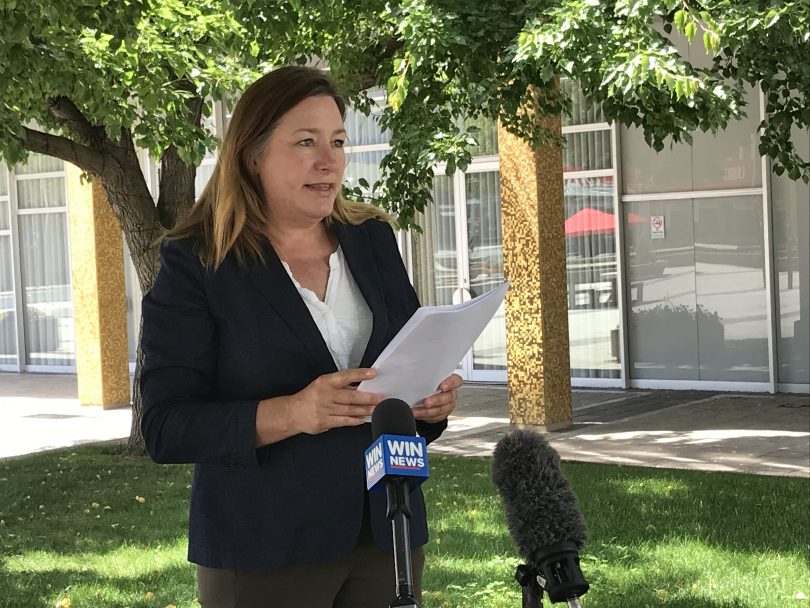
Minister for Education Yvette Berry pleaded for anyone who had been on the school campus since last Monday to come forward and get tested. Photo: Lottie Twyford.
UPDATED 1:15 pm: The cluster of COVID-19 cases linked to Wanniassa School – Junior Campus has now grown to 17 as of 8 pm last night.
An individual was unknowingly infectious at the school campus since Monday last week, including yesterday (2 November) when the school reopened.
It’s now been closed once more while testing of all students, staff and visitors to campus since last Monday takes place.
ACT Chief Health Officer Dr Kerryn Coleman said of the 17 cases, 15 had attended school while the other two were household contacts.
The majority of these cases are symptomatic, but none are in hospital at this time.
The number of close contacts has now grown to at least 120, she said.
Dr Coleman noted the full extent of transmission on the campus would be better understood by the end of today after the testing is completed, and a risk assessment would be made regarding next steps, including reopening.
Minister for Education Yvette Berry issued a plea to the school community to come forward to test and isolate while waiting for a negative result. ACT Health will directly contact any families who have been identified as close contacts.
Although Wanniassa School reopened yesterday, it was forced to shut again when authorities realised there had been greater transmission than initially thought.
And while the vast majority of cases are linked to one student cohort, there is one unlinked case in a different school cohort that is causing some concern for authorities.
The Chief Health Officer said that all teachers at Wanniassa School are fully vaccinated, and no breakthrough infections have yet been recorded.
“This scenario is not unexpected,” Dr Coleman said. “We have expected this. We have seen cases in schools in Victoria and NSW and we have been learning from those experiences.”
“We aren’t going to be able to keep COVID-free schools, but we can have COVID-safe schools,” she added.
On Monday (1 November), the Chief Health Officer indicated she thought 60 to 70 close contacts from a school community requiring to quarantine was “too high”.
When asked about those comments in light of the now 120-strong cohort of close contacts, she said today it “highlights how difficult and challenging this is”.
“Our aim is to minimise the impact on schools – both teachers and students having to stay home from school – so minimising our close contacts as much as possible but doing it in a way that means we are limiting as much transmission as possible.
“I don’t know why this has been different to the situation at Ainslie School, it might be that we picked it up a little later,” Dr Coleman said.
She was unsure what the next two weeks would look like for this cluster given the recent changes to public health settings which have allowed greater freedoms, including the removal of masks outside.
Hog’s Breath Cafe Woden has today been added as the only new casual contact exposure site. It’s a venue of concern on Sunday, 31 October, between 5 pm and 6 pm.
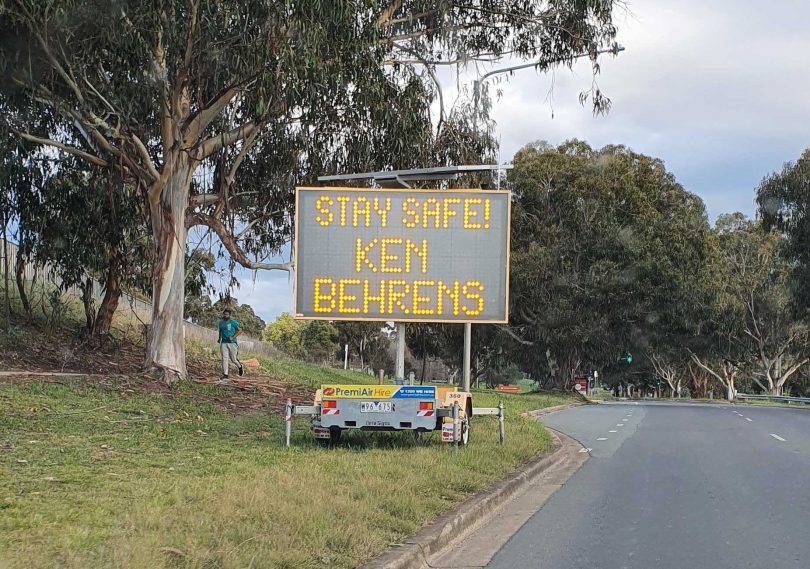
There are 141 active cases in the ACT and 15 in the 24 hours to 8 pm last night. Photo: David Murtagh.
UPDATED 11 am: The ACT has recorded 15 new cases of COVID-19 to 8 pm last night.
Yesterday the ACT had eight cases. In total, there are 141 active cases in the Territory.
There are five people in hospital with COVID, including two in intensive care and one requires ventilation.
Of the ACT’s 12-plus population, 93.6 per cent are fully vaccinated.
NSW has recorded 190 new cases and four deaths.
Yesterday there were 173 new cases and four deaths.
Of the state’s 16-plus population, 93.6 per cent are now fully vaccinated.
Victoria has recorded 941 new cases, the lowest daily infection total since late September. There were also eight deaths, bringing the total number of deaths due to the delta strain to 318.
There were 989 new local COVID cases yesterday.
Of the state’s 16-plus population, 82 per cent are now fully vaccinated.
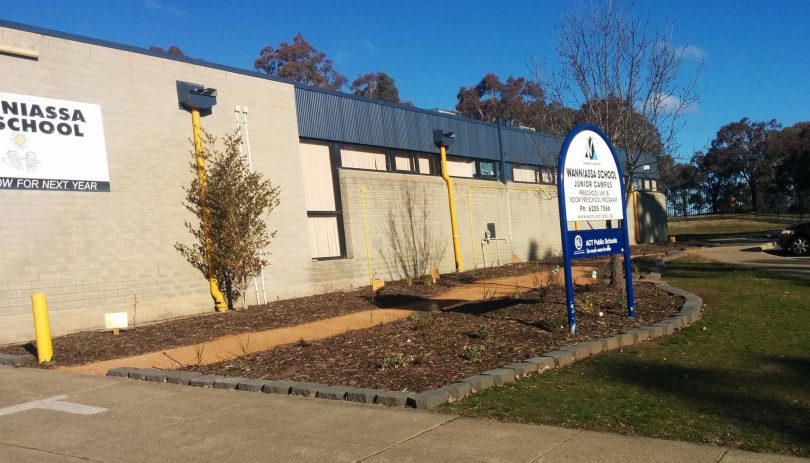
All parents, staff and students who have been on the campus since last week have been asked to get tested and quarantine. Photo: Wanniassa School.
9:50 am: Wanniassa School – Junior Campus is closed again as fears increase about a growing cluster of COVID-19 cases.
ACT Health has advised that all students, parents and staff who have been on campus since last Monday (25 October) must now get tested and quarantine.
A spokesperson for ACT Health previously said the individual had been unknowingly infectious while on-site on Wednesday 27 October, Thursday 28 October and Friday 29 October.
Previously, the school campus had only been shut for one day, Monday, 1 November, to allow contact tracing to occur. It was open again yesterday.
Queanbeyan Public School will also be closed after a COVID-19 exposure on campus. Students and staff have been asked to self-isolate.
A post on the school’s Facebook page said the school and Care for Kids would be non-operational to “allow time for contact tracing and cleaning”.
NSW Health has requested anyone who develops symptoms to get tested immediately, the post read.
It’s unclear how long the school will be closed.
On Monday, Chief Health Officer Dr Kerryn Coleman had estimated that an outbreak at a school could see up to 70 people placed into quarantine, a figure she said was “too high”, and the focus moving forward would be on ensuring schools could remain open where possible.
Now it’s likely the number of people in quarantine will increase.
Ainslie School, Queanbeyan West Public School and Queanbeyan South Public School have all been forced to shut their doors temporarily due to confirmed COVID-19 cases being present on site. All schools have reopened.
At least one school parent took to Facebook to thank the staff at Queanbeyan South Public School for their hard work and efforts communicating with parents after the initial exposure.
The poster also said school staff had gone the distance and dropped off her young daughter’s favourite toy so it could be at home with her during quarantine after she’d brought it to school for a show and tell.
Monday (1 November) was the first day that all students in Canberra had been allowed to return to face-to-face teaching.
Yesterday, Deputy Chief Health Officer Dr Vanessa Johnston told a press briefing that contact tracing and quarantine arrangements for schools would be implemented in a similar way to the new arrangements for the broader community, with vaccinated close contacts subject to less strict requirements.
“This has, obviously, real implications for primary schools,” she said, where students cannot yet be vaccinated.
Dr Johnston said implementing strategies such as staggered break times should mean fewer students are forced into quarantine.
She went on to say that the cleaning protocols for schools were also in the process of being relaxed, with a full deep or terminal clean becoming less necessary.
“The evidence has emerged that just a standard clean of high touch surfaces is sufficient,” she said.
However, Dr Johnston suggested schools may still need to close for some time to allow contact tracing.
More to come.
